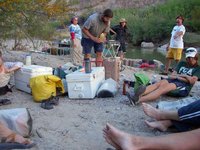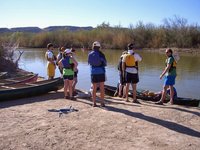EoE in the Classroom
Contents
EoE in the classroom
| Topics: |
This content is not assigned to a topic
|
The articles and other resources in the Encyclopedia of Earth are intended to be useful in both informal and formal education programs. Below are descriptions of some of the ways in which EoE resources have been used in formal education settings. If you have used EoE articles as assigned or supplemental reading in a course that you teach or as background information in preparation for teaching, we would like to hear from you. Please take a few minutes to share your experiences. We hope the experiences described here will show how the EoE can serve as an important resource in the classroom for teachers and students.
|
|
Boston University |
Intermediate Environmental Analysis (Dr. Cutler Cleveland)
Class level: Undergraduate, 50 students
This is an undergraduate class for majors in Environmental Science and Policy that focuses on the role that the environment plays in supporting human well-being. This requires an examination of the nature of natural resources and ecosystem goods and services, how human use them to meet needs and wants, and how they are degraded by such use. The course also examines different methods to measure well-being, as well as the effect that depletion and degradation have on well-being. The concept of sustainability is examined in detail, including the role of substitution and technological change, indicators of sustainability, and green national accounting. The reading list for this includes chapters from the e-Book An Introduction to Ecological Economics (e-book). The nice thing about EoE content is that it provides an accessible but substantial introduction to a subject, and thus develops a knowledge foundation from which a student can explore more complex material.
Energy, Society, and Environment (Dr. Cutler Cleveland)
Class level: Undergraduate/Graduate, 25 students
This course is designed to provide students with the methods, tools and perspectives to understand, critique, and ultimately influence the management of technical, economic, and policy choices regarding the options for energy generation and use. The course focuses equally on the technical, economic, political, and environmental impacts of energy. The readings are derived from various peer-reviewed sources including journals, books and web-based material. I use EoE articles on energy such as Energy transitions past and future, Fundamental principles of energy, and Ten most distortionary energy subsidies.
Mount Holyoke College |
Introduction to Environmental Contaminants and Communicating Science to the Public ( -->Dr. Emily Monosson)
Class level: Undergraduate juniors and seniors, 7-12 students
These classes introduce students to basic concepts in toxicology, environmental contaminants and chemical regulation. There are very few if any texts on these topics suitable for the undergraduate level. The EOE has articles from relevant federal agences including EPA, NIEHS, CDC, USGS, in addition to articles by individual EOE authors on topics ranging from basic toxicology to EPA regulation to Rachel Carson, and international issues with contaminants. It is rare to find all of these topics in one book. The EOE provided me with the opportunity to create the Environmental Contaminants and Toxicology Reader, a text tailored to class needs and which can be easily revised and updated. We use the reader for both classes, and articles written by students in the Communicating Science are added to the reader once approved and published in the EOE.
Texas Tech University |
Ecology for Teachers (Dr. Mark McGinley)
Class level: Graduate, 10 studentsEcology for Teachers is an online distance education course offered for in-service teachers enrolled in the Multidisciplinary Science Masters Degree at Texas Tech University. I am using the Ecology Reader- Ecology for Teachers as the main text for this course. I interact with students in this course using a course blog "Ecology for Teachers".
Biology II (Introductory Biology for Majors) (Dr. Mark McGinley)
Class Level: Undergraduate sophomores, 400 students
Biology II is the second semester of Introductory Biology for Majors at Texas Tech University. During the Ecology section of the course I have used articles from the EoE as a supplement to the class textbook (Biololgy by Campbell and Reece). Readings from the EoE are assigned on the course blog "McG's BIOL 1404". In addition to providing depth and breadth for some topics, using articles from the EoE allows me to provide students for more information about issues such as human population growth and global climate change.
Advanced Fieldcraft: The Rio Grande (Dr. Mark McGinley)
Class level: Undergraduate juniors and seniors, 10 students
Advanced Fieldcraft is a course intended for students majoring in Natural History and Humanities at Texas Tech University. The goal of this class is to introduce students to how the physical environment has affected the ecology, natural history, history, culture, and envioronmental issues along the Rio Grande River. Students take a week-long canoe trip down the Rio Grande River through Big Bend National Park during spring break. I have assigned readings from the EoE as the major readings for the course. Readings from the EoE are assigned on the course blog "Rio Grande Class". An interesting component of this course is that some of the course readings were written by previous students who participated in the EoE's Student Science Communication Project. Students in the current class will also participate in the Student Science Communication Project as part of their assessment for this course.
University of Montana |
Critical Thinking and secondary research methods (Dr. Vicki Watson)
I teach a class in critical thinking and secondary research methods to develop position papers on controversial environmental topics. We spend a good bit of time trying to convince students that research does not consist of Googling a topic and then copying and pasting from the first few hits they get. We explain about peer reviewed research and that tertiary sources like encyclopedias are a good place to start getting an overview of an issue. We also explain that the Encyclopedia of Earth is exceptionally useful because it is peer-reviewed, frequently updated, focused on the environment, and cites scholarly sources--which really helps them to get started and go beyond what they find on the EoE.
University of North Carolina at Chapel Hill |
Marine Ecology (Dr. John Bruno)
I regularly use EoE articles in teaching at UNC. For my Marine Ecology course (MASC 440) I use articles on topics ranging from Marine reserves to Biodiversity, but I find the collection on Climate Change particularly useful.
Coral Reef Ecology and Conservation (Dr. John Bruno)
I also teach a smaller, undergraduate seminar class on Coral Reef Ecology and Conservation and use many EoE resources as background reading for the class. And last year the main class project was for the students to write EoE articles, instead of term papers. Five of these were published in EoE and the rest were archived on a web site the students set up: All About Coral Reefs. Probably the most frequent use of EoE content to give students background info on various topics that they plan to write research papers on. EoE makes it very easy for students to explore material before settling on a subject and doing a more thorough investigation.
University of Vermont |
Ecological Economics (Dr. Robert Costanza)
Class level: Graduate, 13 students
Ecological Economics is a fully online course found at MetaCourses.com. It utilizes many EoE articles to provide students with a core foundation for Ecological Economics issues. Students are required to read the e-book "An Introduction to Ecological Economics" and strongly encouraged to read the e-book "Capitalism 3.0: A Guide to Reclaiming the Commons." Other articles are used to provide students with an transdisciplinary perspective on global issues and give them case studies of practical instances in which ecological economics has been used. Next semester, student's will be asked to outline and start filling in a new collection on Ecological Economics for the EoE as their semester project.
Introduction to Ecological Economics ( -->Dr. Carol Franco)
Class level: Undergraduate juniors and seniors, 55 students
Introduction to Ecological Economics is an undergraduate course which has students collaborating with experts within Ecological Economics on EoE entries. The students choose a seminal, peer-reviewed paper on a Ecological Economics topic from the list provided in the article published by Costanza et al., 2004 "Influential publications in ecological economics: a citation analysis". The students are asked to write a article of approximately 1500 words for the Encyclopedia of Earth summarizing the seminal paper at a level appropriate for the EoE. This summary will include a literature review on the topic of the paper and separately a brief bio of the author(s) to be also included in the EoE. Each student must contact and get agreement from the author(s) of the original paper since the original author will review the summaries and be placed as a co-author on those EoE article.
Once the student writes the piece, it will have to be approved by the original author or reedited by the student until the original author approves. Once the original author approves the piece, it will be put up on the EoE to await the normal review by EoE topic editors. All pieces will have the original authors as co-authors on these EoE pieces, and the student will be first author.
Conservation Techniques and Approaches (Dr. Deane Wang)Conservation Techniques and Approaches (Dr. Deane Wang)
Graduate students at the University of Vermont.Conservation Techniques and Approaches starts with understanding foundational concepts in ecology that support conservation planning and management. As part of their coursework, students use EoE and other peer-reviewed resources to learn about these concepts. Where entries in EoE do not exist, students are responsible for developing an entry that is targeted at the general public but also useful to educational audiences (high school, college). These relatively brief and concise entries are reviewed by content faculty at the university and then submitted to EoE.
Students in the class also examine different conservation approaches through readings in the original literature, using a Blog and Wiki to explore strengths and weakness of the different approaches and perspectives.
Course link: http://www.uvm.edu/envnr/nr385cta



